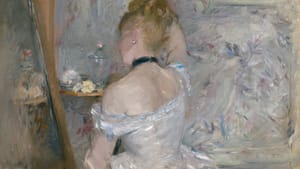Stay in the Loop
BSR publishes on a weekly schedule, with an email newsletter every Wednesday and Thursday morning. There’s no paywall, and subscribing is always free.
Impressionism's overlooked founder
Barnes Foundation presents 'Berthe Morisot: Woman Impressionist'

The subject of the Barnes Foundation's Berthe Morisot: Woman Impressionist may be the least-known Impressionist. She was a critically acclaimed peer of Edgar Degas, Pierre-Auguste Renoir, and Claude Monet and, though her work was later eclipsed by her more celebrated male contemporaries, she is considered a founder of the movement.
A female point of view
Morisot’s gender both limited and liberated her painting. She could not venture into cafés or brothels to sketch as male artists did, but was privy to spaces where men were not welcome. Morisot had access to boudoirs where women bathed, dressed, and prepared to meet societal expectations: the places in which they were most themselves.
In Woman at Her Toilette (1875-80), she reveals a young woman checking her upswept hair in a mirror. Morisot positions viewers behind the subject but to the side, so the reflection is unseen. The focus is on the subject’s outstretched arm, the curve of her neck and upper back, shimmering silver-white gown and the wall of her dressing room, papered in a chrysanthemum-like burst of brushstrokes, indistinct but solid.
Nude Seen from Behind (1885) is atypical for the French painter: Morisot rarely portrayed nudes, and when she did they were models, rather than the intimates who were her usual subjects. Here, the woman sits on the edge of a tub, towel draped around her waist. She’s turned away and the narrowest sliver of breast is visible. Morisot equalizes the situation by having her subject look over her shoulder at viewers. She’s not frightened, not coy, and sees us watching her.
Painting women at work
Morisot painted mostly women and depicted them differently than male artists did. Her sisters Yves and Edma, daughter Julie, and household staff were frequent subjects.
As a middle-class wife and mother, Morisot had help with laundry, cooking, and childcare, and she observed the women who worked in her home with a discerning, respectful eye.
In The Fable (1883), Julie sits on a bench, looking intently at her nanny Pasie as though listening to a story. Young women lean into needlework in the sun-splashed Embroidery (1888-89), and in In the Dining Room (1880), Morisot places the viewer behind a cook standing at her temporarily idle stove, underscoring the endless chore that feeding a family can be.
In committing to canvas people and tasks men might take for granted, Morisot visually acknowledges the women and labor that afforded her the freedom to be a transformative painter.

Following Impressionist instincts
In Hanging the Laundry Out to Dry (The Gennevilliers Plain) (1875) lines of linens flutter in the breeze, as much a crop as the vegetables in the adjacent garden. Morisot embraced painting outdoors, influenced by an early teacher, landscape artist Jean-Baptiste-Camille Corot, whose instruction went beyond the drawing lessons customary for girls in bourgeois families. He taught Morisot and Edma as promising young painters.
The Manet connection
With indefinite edges, amorphous figures rendered in quick brushstrokes to capture ever-changing outdoor conditions, Hanging the Laundry creates an undeniable sense of place, people, and action that exemplifies Impressionism. Over her career, Morisot’s work became increasingly expressive and less finished.
Morisot abandoned the more conventional state-run salon in 1874 to establish with others a separate Impressionist exhibition, against the advice of her friend and eventual brother-in-law Édouard Manet. She remained at the movement’s forefront, outselling peers Renoir and Monet, encouraged Mary Cassatt and Eva Gonzalez, and singlehandedly organized the final Impressionist show in 1886.
Though Manet was sometimes portrayed as Morisot’s mentor, they were peers. She was inspired by his modern approach, and he took up en plein air painting because of her. Equally important, the relationship led Morisot to her husband, Manet’s brother Eugène, a painter who gave up his career to manage hers.

Implying what can’t be seen
Morisot painted women of her own class engaging in expected activities, but she incorporates a subversive undercurrent through her subjects’ ambiguous, unreadable expressions. In The Cradle (1882), perhaps Morisot’s most familiar image, Edma gazes into the bassinet of her tiny daughter Blanche.
The scene is a series of connecting curves: the veil draped over the oval cradle, the sleeping infant’s cheeks and arms. It’s all peaceful contentment, except for Edma’s dazed, tired visage.
In Winter (1880), a beautifully dressed woman leans as though preparing to leave the frame. Has she spied someone across the room she’d rather avoid? Young Woman on a Divan (1885) is blank-faced in wonderment, and Paule Gobillard in Her Ball Gown (1887) is as pale as her icy apparel. She looks down and off to one side, forlorn.
Morisot invests her women with intellect, forcing the viewer to look beyond the lovely clothes and placid faces. She makes us question what these women are thinking.
Between two worlds
Thresholds are a recurring theme. Morisot puts subjects in doorways, by open windows, and on balconies, perhaps symbolizing how she stood between worlds.
The artist most often painted not in a studio but a park, a bedroom, a parlor — places that served dual purposes, as she did, maintaining family and home while building a critically recognized career in a male realm. Morisot knew that rooms, like women, could adapt, and by bridging the gap between societal expectations and artistic necessity, she made her gender benefit her art.
What, When, Where
Berthe Morisot: Woman Impressionist. Organized by the Barnes Foundation; the Musées d’Orsay et de l’Orangerie, Paris; the Dallas Museum of Art; and the Musée National des Beaux-Arts du Québec. Through January 14, 2019, at the Barnes Foundation, 2025 Benjamin Franklin Parkway, Philadelphia. (215) 278-7000 or barnesfoundation.org.
Sign up for our newsletter
All of the week's new articles, all in one place. Sign up for the free weekly BSR newsletters, and don't miss a conversation.
